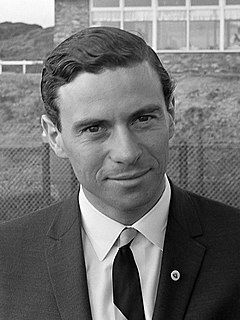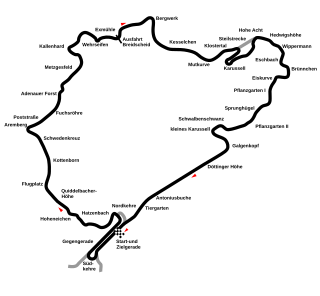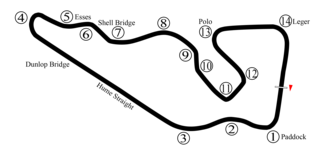
James Clark Jr. OBE was a British Formula One racing driver from Scotland, who won two World Championships, in 1963 and 1965. A versatile driver, he competed in sports cars, touring cars and in the Indianapolis 500, which he won in 1965. He was particularly associated with the Lotus marque.

The Australian Grand Prix, is an annual motor racing event, which is currently under contract to host Formula One until 2025. It is the second oldest surviving motor racing competition held in Australia, after the Alpine rally of East Gippsland. The Grand Prix has moved frequently with 23 different venues having been used since it was first run at Phillip Island in 1928. The race became part of the Formula One World Championship in 1985. Since 1996 it has been held at the Albert Park Circuit in Melbourne, with the exceptions of 2020 and 2021 when the races were cancelled due to the COVID-19 pandemic. Before that, it was held in Adelaide. It is currently sponsored with naming rights by Swiss watchmaker Rolex.

The 1961 German Grand Prix was the 23rd time the German Grand Prix motor race was held. The race also held the honorary designation of the 21st European Grand Prix. It was run to Formula One regulations as race 6 of 8 in both the 1961 World Championship of Drivers and the 1961 International Cup for Formula One Manufacturers It was held on 6 August 1961 over 15 laps of the giant 14.2 mile Nürburgring Nordschleife circuit for a race distance of almost 213 miles. The race also celebrated the 100th race since the establishment of the World Championship in 1950.

The 1966 French Grand Prix was a Formula One motor race held at Reims on 3 July 1966. It was race 3 of 9 in both the 1966 World Championship of Drivers and the 1966 International Cup for Formula One Manufacturers. The race was the "60th Anniversary race" of Grand Prix racing, which had started with the GP of France in 1906. It was also the 16th and last time the French Grand Prix was held on variations of French highways near Reims, following a three-year absence from the region. The race was held over 48 laps of the 8.35-kilometre (5.19 mi) circuit for a race distance of 400 kilometres (250 mi).
The 1968 Formula One season was the 22nd season of the FIA's Formula One motor racing. It featured the 19th FIA World Championship, which commenced on 1 January, and ended on 3 November after twelve races, and numerous non-championship races.
The 1966 Formula One season was the 20th season of FIA Formula One motor racing. It featured the 1966 World Championship of Drivers and the 1966 International Cup for F1 Manufacturers which were contested concurrently over a nine-race series that commenced on 22 May and ended on 23 October. The season also included a number of non-championship races for Formula One cars.
The 1961 Formula One season was the 15th season of Formula One motor racing. It featured the 1961 World Championship of Drivers and the 1961 International Cup for F1 Manufacturers, which were contested concurrently from 14 May to 8 October over an eight race series. The season also included numerous non-championship races for Formula One cars.
The 1960 Formula One season was the 14th season of the FIA's Formula One motor racing. It featured the 11th FIA World Championship of Drivers, the third International Cup for F1 Manufacturers and numerous non-championship Formula One races. The World Championship commenced on 7 February and ended on 20 November after ten races. Jack Brabham won his second consecutive title with his Cooper team defending its constructors' title.
The 1962 Australian Drivers' Championship was a CAMS sanctioned motor racing title for drivers of Formula Libre racing cars. The winner of the title, which was the sixth Australian Drivers' Championship, was awarded the 1962 CAMS Gold Star.
The 1964 Tasman Series was an international motor racing series contested in New Zealand and Australia over eight races beginning on 4 January and ending on 2 March. It was the first Tasman Series. The series, which was officially known as the Tasman Championship for Drivers, was organised jointly by the Association of New Zealand Car Clubs Inc. and the Confederation of Australian Motor Sport with the winning driver awarded the Tasman Cup. The championship was open to racing cars using unsupercharged engines of up to 2,500 c.c. capacity.
The 1963 Australian Drivers' Championship was a CAMS sanctioned national motor racing title for drivers of Formula Libre cars with the championship winner awarded the 1963 CAMS Gold Star. The title was contested over a six-round series:

Warwick Farm Raceway was a motor racing facility which was in operation from 1960 to 1973. Warwick Farm Raceway hosted numerous major events during its life such as the Australian Grand Prix and rounds of both the Australian Touring Car Championship and the Tasman Series.

The 1967 Australian Grand Prix was a motor race held over 45 laps of the 3.621 km (2.25 mi) Warwick Farm Raceway in Sydney, New South Wales, Australia on 19 February 1967. The race, which was open to Australian National Formula and Australian 1½ Litre Formula cars, had 15 starters.
The 1964 Australian Grand Prix was a motor race held at the Sandown Park circuit in suburban Melbourne, Victoria, Australia on 9 February 1964. It was the twenty ninth Australian Grand Prix and was also Round 5 of the 1964 Tasman Series and Round 1 of the 1964 Australian Drivers' Championship. The race was open to Racing Cars complying with the Australian National Formula or the Australian 1½ Litre Formula.

The 1965 Australian Grand Prix was a motor race held at the Longford Circuit in Tasmania, Australia on 1 March 1965. It was open to Racing Cars complying with the Australian National Formula or the Australian 1½ Litre Formula. It was the 30th Australian Grand Prix.

The 1971 Australian Grand Prix was a motor race held at Warwick Farm Raceway in New South Wales, Australia on 21 November 1971. It was open to Racing Cars complying with either Australian Formula 1 or Australian Formula 2 regulations.
The 1962 Australian Grand Prix was a motor race for Formula Libre cars, held at the Caversham circuit in Western Australia, Australia on 18 November 1962. It was the twenty seventh Australian Grand Prix and the sixth and final race in the 1962 Australian Drivers' Championship. The Grand Prix meeting was organised by the Western Australian Sporting Car Club Inc.

The 1961 Australian Grand Prix was a Formula Libre motor race held at the newly completed Mallala Race Circuit in South Australia on 9 October 1961. The race, which was Round 5 of the 1961 Australian Drivers' Championship, had 17 starters.
The 1956 Australian Grand Prix was a motor race for Formula Libre cars held at Albert Park Street Circuit, in Victoria, Australia on 2 December 1956. The race, which had 22 starters, was held over 80 laps of the five kilometre circuit, the longest of all the Australian Grands Prix at 402 kilometres. It attracted a crowd of over 120,000 spectators.
The 1965 Australian Drivers' Championship was a CAMS sanctioned Australian national motor racing title open to racing cars complying with the Australian National Formula or the Australian 1½ Litre Formula. The title was contested over a six race series with the winner awarded the 1965 CAMS Gold Star. It was the ninth Australian Drivers' Championship.








